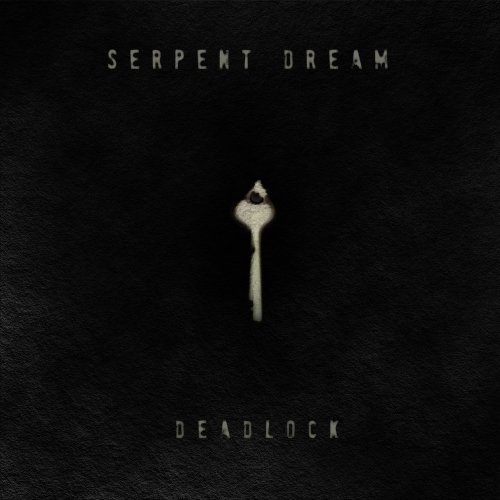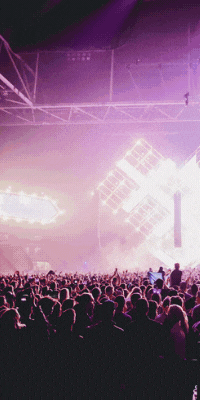Serpent Dream - EP Review: Deadlock
 You could be forgiven for anticipating a heavy metal with a
cover and title like this. A glowing photogram of an Australian
mental health institution key hints at themes of incarceration
and of security or danger. One might ask, before the recording
begins, are we looking through the key? Are we looking in or
out?
You could be forgiven for anticipating a heavy metal with a
cover and title like this. A glowing photogram of an Australian
mental health institution key hints at themes of incarceration
and of security or danger. One might ask, before the recording
begins, are we looking through the key? Are we looking in or
out?
With expectations of loud guitars and drums, (having entered the album totally fresh), I was surprised by a soundscape inhabited by field recordings of running water and electronic noises that burbled in deep reverb.
The opening track, Manifest – Manifold, still had me thinking some heaviness might be around the corner with a rising tone, but this breaks into soulful acoustic guitar lines over a droning note. Then, when a soft voice interrupts, the guitar ceases causing the listener to concentrate on only one aspect above the drone. This is followed by a mournful violin, before the guitar joins again and finishes the track with beautiful arpeggiating chords that weave above the thin layers. Although few words could be made out, the tone of the voice was not full of dread or warning, but a type of bittersweet welcome. The next track, Dead Reckoning, establishes the sound more solidly without the build-up, but the vocals are clearly warning us to ‘wake up’.
A rising and distorting violin line transforms into an electrical signal that fizzes in Stalking Shadows, while the mournful tone of a Koauau (Maori flute) can be heard in Apparitions. There are vocals present in these songs, but like the opening track, they are too distorted to make out words, if indeed there are any words to be heard. I was reminded of the nonsense lyrics of Icelandic post-rock outfit, Sigur Rós, whilst trying to determine any words, but in doing so I became quiet and attentive.
And maybe that’s the point; to listen without pretension to these familiar instruments in an unfamiliar background. Although there are rhythms to be found here, the sounds are shown very much on their own against the drone notes or the field recordings. There is some layering, but the instruments are shown as they would be in an art gallery: on a plinth against a plain background to admire them. A nylon-string acoustic guitar is played throughout the recording, occasionally with reverb, but without it also which makes it seem intimate and close. Percussive footsteps walk toward or away from us as Apparitions comes to a close, but then electric guitar returns with a vengeance, played in such a way as to emphasise the otherness of this instrument compared to its acoustic counterpart that has brought us here. Disconcerting heavy breathing in the same rhythm closes the track. Breathing Space offers a different approach by seeming to take the audience on an adventure through water, beginning with what sounds like underwater noises, until we are splashing above the surface rhythmically.
Dream Eater, perhaps the most conventional track, begins with acoustic guitar leaving such long pauses I checked my player. The intention, again, is to keep the listener attentive, and quiet, which I was. After some vaguely swampy blues playing, a beat emerges, and then a rising noise that reveals itself as the voice appears, before washes of electric guitar join the throng and a stoner doom riff establishes a dirge. An incredibly distorted noise brings the track to a sudden and abrupt end on a dime. The final track, Kistvean (a Celtic tomb) begins with the sounds of a tightening rope, backward vocals and violins. The last minute is small ticks of static that make you worried there will be some surprise, but the recording ends and you start to breathe and move normally again.
I found myself distracted listening to the tracks, but not in a bad way. I began staring at objects, doodling a little and thoroughly intrigued by the scope and intelligence of the recording. I researched a little about Serpent Dream to find a website dedicated to a certain aesthetic sound engineer James Costin has established utililising the natural world (except for NASA audio samples used in his first EP, 2019’s The Language of Things) and a mix of electric and acoustic instruments incorporating world percussion. His most recent before Deadlock, 2021’s Nova is (according to the artist) an “inter-art cohesive audio-visual project, combining composition, sound design, and audio manipulation” presented in combination with psychedelic imagery utilising vertical and horizontal reflections of natural beauty or painted bodies. One wonders what possible visualisations this very different recording would offer. Although I am sure there are different interpretations of Deadlock, to me at least, it was not a message of being trapped but about healing and finding an escape.
I found the record intriguing and worthy of another listen, though less active listening was more enjoyable. Perhaps whilst doing yoga, gentle exercise, making art or indeed walking in the natural world would be appropriate for listening to this, provided the audience knows there are some surprises along the way and some darkness amongst the beauty. Another way to listen, in order to hear every detail, would be to meditate with it.
By the end of the seven tracks, I realised as the artist may have planned, the symbol of the key on the cover has a reflective nature. The key to healing or freeing us is ourselves.
About Serpent Dream
Drawing from the natural environment, the inner mind and perceptions of human experience, this marked the beginning of Serpent Dream's surreal, electro-acoustic music and introspective soundscapes.
With an Advanced Diploma of Audio Production under his belt, James continued these sonic explorations and traveled from his hometown of Canberra, Australia capturing sound and experiences along the way.
Visit the muzic.net.nz Profile for Serpent Dream
Releases
Other Reviews By Nicholas Clark
 Job Site - EP Review: The New Zealand Experience
Job Site - EP Review: The New Zealand Experience
15 Oct 2024 // by Nicholas Clark
Emerging from the Waikato, high energy punk band Job Site showcases their special blend of comedic music on their latest offering, the 4 track The New Zealand Experience EP. The band plays fast and heavy throughout the recording, with rhythms that range from oi-punk, thrash music and even a little 2000’s indie rock.
Read More...
03 Sep 2024 // by Nicholas Clark
Six iconic venues. Twenty eight acts.
Read More...
 Voodoo Bloo - Album Review: Dead-end Rodeo
Voodoo Bloo - Album Review: Dead-end Rodeo
28 Aug 2024 // by Nicholas Clark
Rodeos, at least in this country, aren’t perceived as sport nowadays. If the term is used at all in New Zealand it usually refers to a metaphor for an intense struggle to survive or to conquer the unconquerable, if but for fleeting moment.
Read More...
 Gig Review: Bad Schematics @ Moon, Wellington - 26/07/2024
Gig Review: Bad Schematics @ Moon, Wellington - 26/07/2024
27 Jul 2024 // by Nicholas Clark
Fresh from picking up numerous awards in the recent National Battle of the Bands competition, Bad Schematics have embarked on a North Island tour including Tauranga, Auckland and their hometown Palmerston North, to promote their newest album,C O L L I D E. Tonight, along with winners of the competition for this year, Adoneye, finalists Donal and The Bucks and last year’s second place winners, Dave and the Dirty Humans, Bad Schematics hit Wellington’s favourite underground alternative music venue and pizzeria, Moon.
Read More...
 Gig Review: Floyd Marsden @ Valhalla, Wellington - 18/07/2024
Gig Review: Floyd Marsden @ Valhalla, Wellington - 18/07/2024
19 Jul 2024 // by Nicholas Clark
Although technically a sad affair, (as it was to be final of Floyd Marsden’s string of local shows promoting her album The Disco Lizards), the atmosphere in Valhalla was uncharacteristically filled with retro vibes but the usual friendly faces. In support for this show was Adult Friends, spearheaded by vocalist/guitarist Jackson Kidd who was also the producer of The Disco Lizards.
Read More...
 SuperMild - EP Review: SuperMild
SuperMild - EP Review: SuperMild
11 Jun 2024 // by Nicholas Clark
SuperMild is a busy band playing lots of venues and entertaining crowds with their blend of reggae tinged psychedelic rock. Their debut, self-titled four song EP is out now, and it spans the many sounds the band can summon with just three members.
Read More...
 Anecdata - Album Review: Obsolete
Anecdata - Album Review: Obsolete
05 Jun 2024 // by Nicholas Clark
Anecdata is a one man band, Dan, who proves without a shadow of a doubt that a single person can be far more prolific than a band of many members. He has recorded nine albums and a number of singles, dabbling in various genres (grunge pop as well as new wave inspired rock) and done covers also including New Zealand classic Sierra Leone, originally by Coconut Rough, and two Beatles covers (I Am The Walrus, and Things We Said Today).
Read More...
 Carb On Carb - Album Review: Take Time
Carb On Carb - Album Review: Take Time
16 May 2024 // by Nicholas Clark
Carb on Carb was a busy, touring band until the lockdowns of 2020 and 2021. While promoting their first two full length albums, For Ages and their self-titled debut, James Stuteley (drums / vocals) and Nicole Gaffney (guitar / vocals) toured as far as Japan and the US, as well as extensively throughout New Zealand.
Read More...
Most Viewed Artists
Latest Galleries
NZ Top 10 Singles
- APT.
ROSÉ And Bruno Mars - DIE WITH A SMILE
Lady Gaga And Bruno Mars - BIRDS OF A FEATHER
Billie Eilish - TASTE
Sabrina Carpenter - I LOVE YOU, I'M SORRY
Gracie Abrams - ESPRESSO
Sabrina Carpenter - SAILOR SONG
Gigi Perez - LOSE CONTROL
Teddy Swims - A BAR SONG (TIPSY)
Shaboozey - GOOD LUCK, BABE!
Chappell Roan












 Report A Problem
Report A Problem

